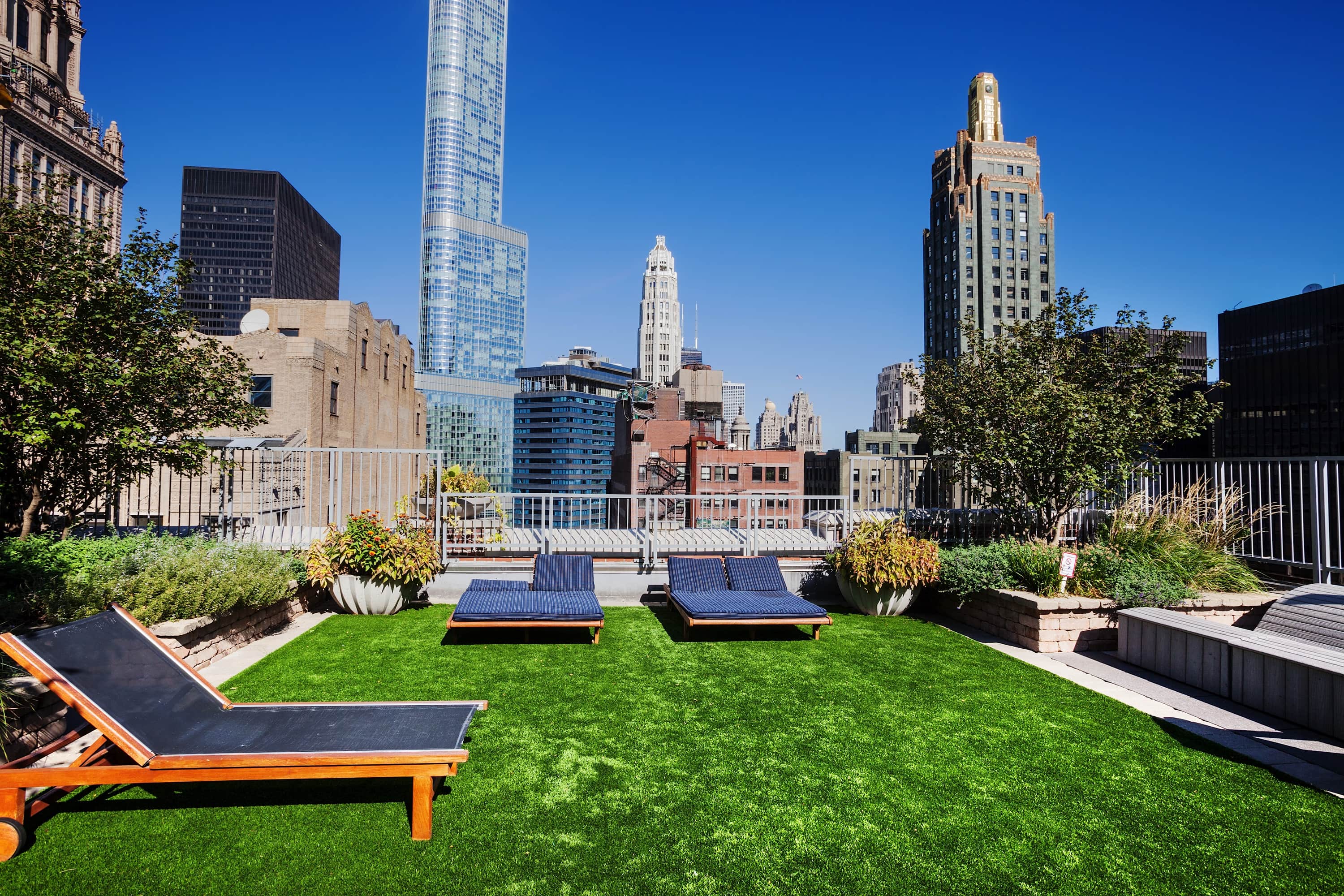“Green roof” is one of many names given to an assembly of materials including plants that is installed over built construction. Also known as living roofs, eco-roofs, vegetated roofs, and rooftop gardens, a green roof is an extension placed above a typical roof surface. A green roof can also be at ground level over an underground built structure.
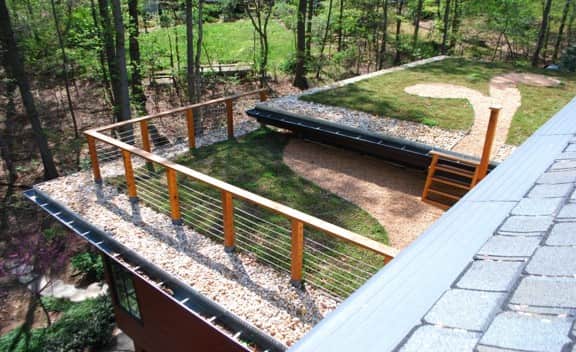
Green roofs have been around for thousands of years. In Mesopotamia, stepped pyramids called ziggurats were built with rooftop gardens as early as the third millennia BCE. The modern green roof system was developed in Germany in the 1960s, primarily in response to rising energy costs and the realization of the damage caused by urban stormwater runoff.
The components of a green roof include a root repellant barrier, a drainage system, filter cloth, a lightweight growing medium, and plants. All of these are placed above the waterproof membrane of a flat or shallow-pitched roof surface. An edge treatment of metal or plastic is typically installed to separate the vegetated area from the edge of the roof.

Growing medium is not soil. It is composed of shale and/or slate (approximately 50 percent) that is super-heated to produce a lightweight, engineered mixture that captures the nutrients in rain to sustain the plants. Other materials in the growing medium include sand, clay, and sanitized compost. The water that passes through is held in the drainage layer for plants to absorb. Any overflow runs under the assembly to the roof drains.
The components can be installed individually, known as “built-in-place,” or in a modular system of trays that are pre-grown at a nursery with growing medium, filter fabric, and an integral drainage layer. As the green roof industry continues to grow, new products and systems are developed and introduced into the marketplace.
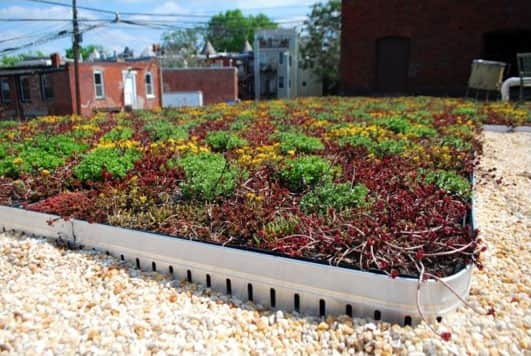
Buildings with a roof parapet commonly include an 18-inch stone ballast perimeter between the vegetated area and the parapet. Roof drains, vents, HVAC units, and other equipment are surrounded in stone ballast with edging to deter roots from penetrating the membrane and clogging the drains.
Careful planning required
Green roofs come in two types: extensive and intensive. The growing medium for extensive green roofs is less than 6 inches deep; for intensive roofs, it is more than 6 inches deep. Extensive green roof installations are planted almost exclusively with sedums, low-growing succulents whose roots tend to grow laterally and are extremely hardy in both wet and dry conditions. Since extensive green roofs are shallower, they cost less to install and weigh less.

With greater medium depth, intensive green roofs can support a wider range of plants, including grasses and perennials. In fact, there are trees planted on some intensive green roofs with growing medium 2 feet or more in depth. Intensive installations are heavier, cost more in labor and materials, and require more maintenance. Engineering of the roof structure must account for the added weight when a green roof is in the scope of work.
When planning for a green roof, several considerations are necessary. First, why do it and what is its intended use? Is it to meet a local stormwater regulation, to create an amenity space, to grow food, to provide habitat for urban wildlife? Depending upon its purpose, design and planning elements will follow and align with its use.

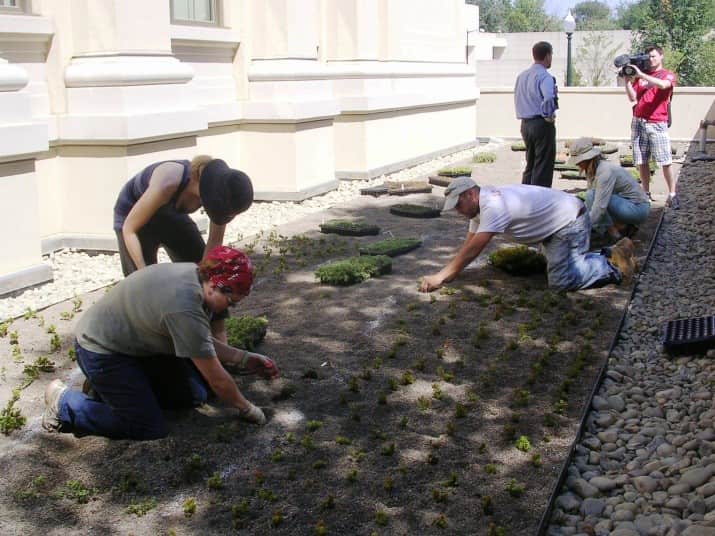
The roof structure and the building’s overall structure need to be designed to hold the added weight of a green roof. A 4-inch extensive green roof typically adds 30 pounds per square foot to the roof load capacity. Intensive green roofs are heavier and may add 60 or more pounds per square foot of roof load.
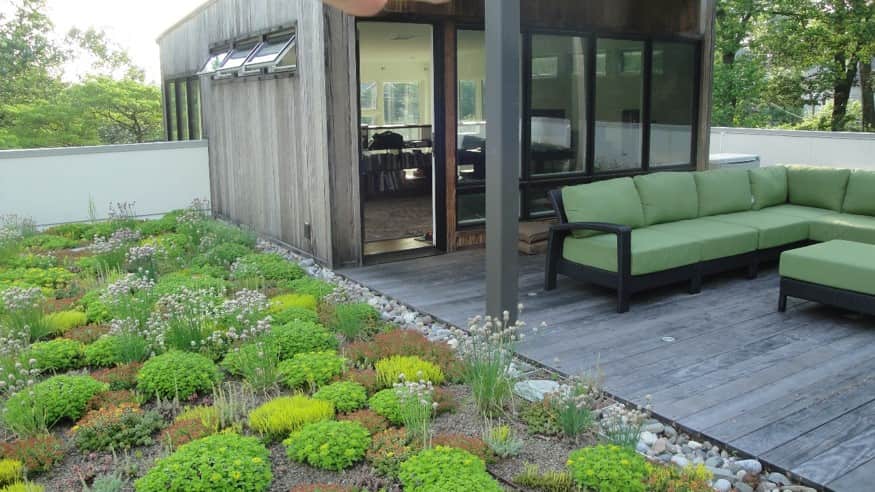
This green roof is about 6 inches deep, which allows for a more varied selection of plants. 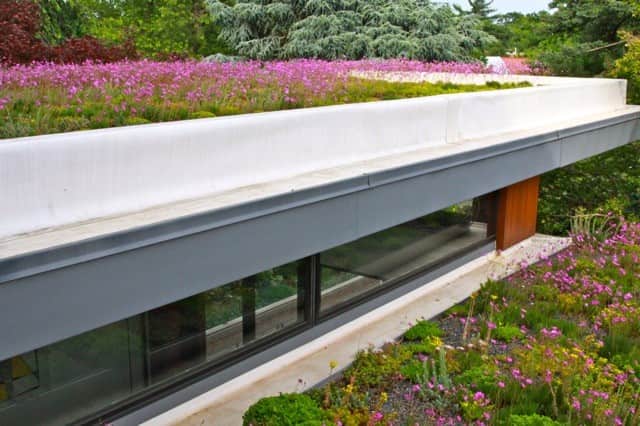
Several wildflower species were selected for this pair of green roofs in Washington, D.C. 
A custom-designed green roof features sedum plants and allium. 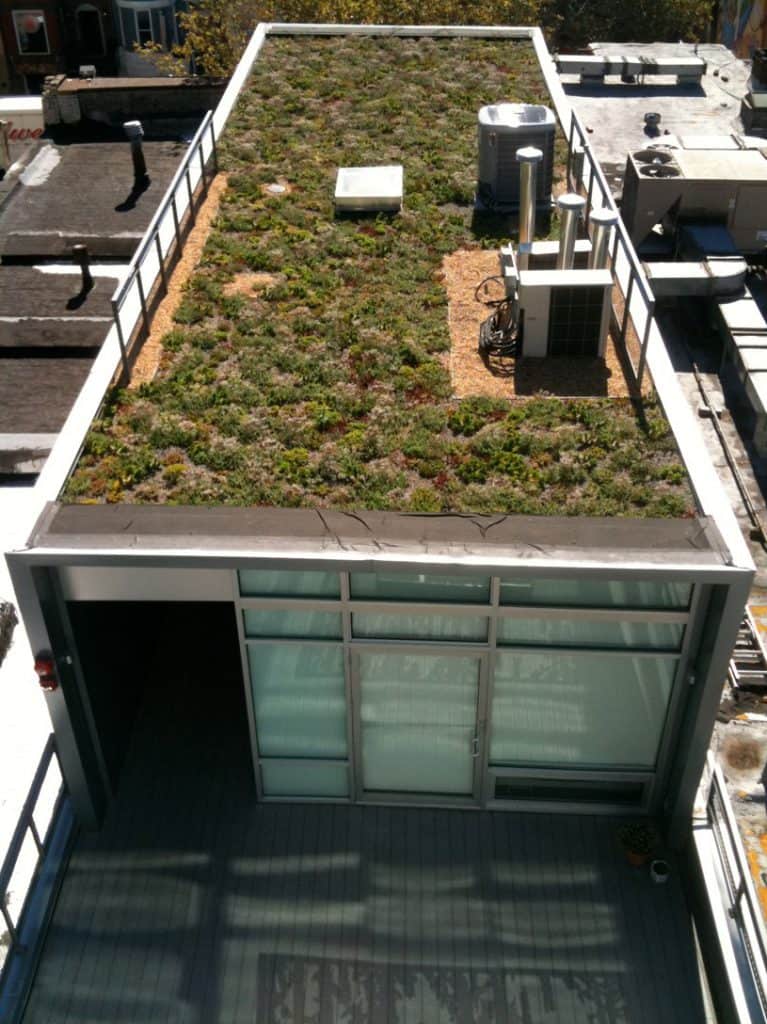
A year after 2-inch sedum plugs were planted, this green roof on an embassy in Washington, D.C., is fully mature.
Defining access to the roof in the design process is critical for the construction phase and future maintenance needs. For the contractor, delivery, staging, and transport of materials to the rooftop are also to be addressed in the planning phase. Rooftop safety is important, and local and OSHA regulations have safety standards for work on rooftops. Building codes have requirements for tie-offs when there are low or no parapets.
Stormwater management, energy efficiency among benefits
Green roofs have economic, environmental, and social benefits. They are most often built in urban areas to address the growing problem of stormwater running into waterways. As cities attract more people, more impervious surfaces are built and runoff volume increases. Runoff carries trash, pollutants, fertilizers, and pet waste into rivers and streams, raising nutrient loads that damage aquatic life.
The sheer volume of runoff erodes stream banks and adds sediment to the waterways, causing more damage. More than two dozen major U.S. cities have regulations to reduce runoff through the use of green infrastructure, including green roofs. The requirements are accompanied by incentives that include rebates, cost-sharing, tax credits, and expedited permitting.
Green roofs increase energy efficiency. The plants and growing medium serve as an insulator, helping to moderate indoor temperatures in both summer and winter. Climate zone, siting, and building configuration affect the extent of energy savings. In some buildings, utility cost savings have been measured in excess of 70 percent.
We have all experienced how temperatures are higher in cities than in rural settings. This is known as the urban heat island effect. Standing on the sidewalk next to a high-rise in summer is uncomfortable compared to walking through a forest. High temperatures in Chicago in July 1995 caused more than 700 deaths in five days and led the city to institute a green roof program. By 2017, Chicago had 5.5 million square feet of green roof coverage. As an example of the benefits green roofs can offer in urban centers, Chicago City Hall’s award-winning green roofaverages 7 degrees cooler than surrounding roofs, and as much as 30 degrees cooler in the summer.
A more pleasant environment
Many other benefits are derived from green roofs. The rooftop plants not only cool the surrounding air temperature, they also trap particulates from chimneys and vehicle exhaust improving air quality. Plants attract insects, pollinators, and birds into the urban landscape, creating a more diverse and resilient habitat community and restoring migratory flight patterns. In combination with the growing medium, the plants lower noise levels, reduce electromagnetic radiation, and suppress fire potential.
Green roofs protect the roof surface, extending the life of the membrane and reducing waste through fewer replacements. Green roofs also create jobs in installation, maintenance, agriculture and product manufacture, as well as in ancillary services to the industry. Buildings with green roofs are more marketable by offering an amenity space or simply a pleasing view of plants.
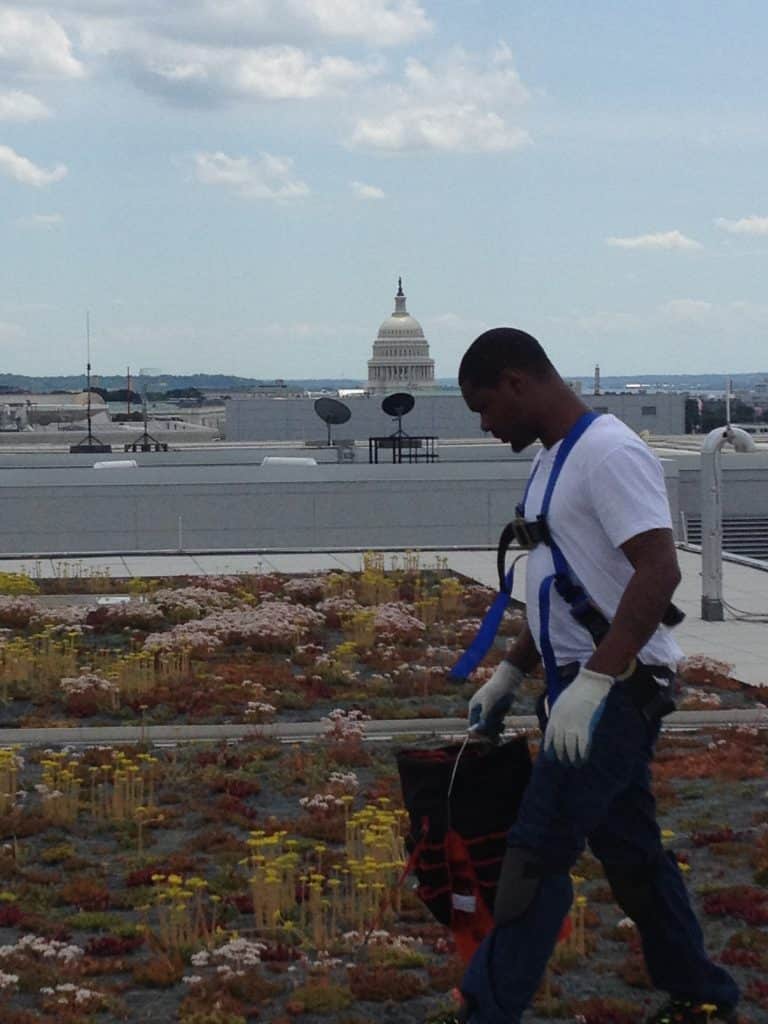
Multiple studies have found that plantings and gardens, especially in urban areas, improve people’s physical, mental, and psychological well-being. Even if the green roof is experienced only visually through the windows, people have lower stress and improved job performance.
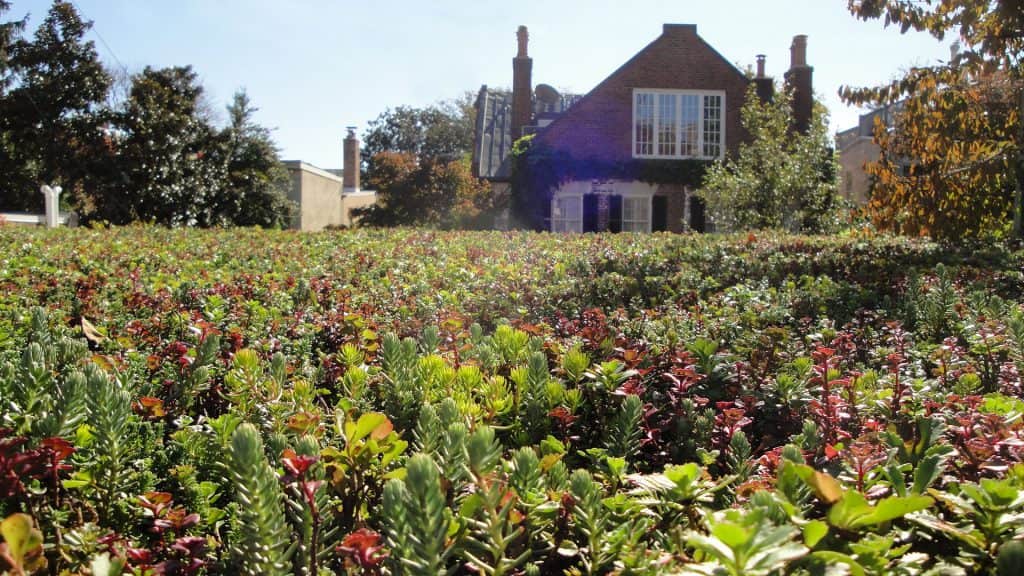
Green roofs are more expensive than conventional roof finishes and have ongoing maintenance requirements. Yet in comparison to the costs of building new and replacing old gray infrastructure (underground piping and storage) for runoff reduction alone, the costs of green roofs and other green infrastructure technologies is much less. If you add the many other benefits, green roofs are a wise investment.
